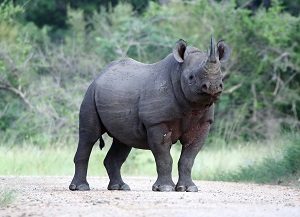
Once abundant from the Cape of Good Hope to Transvaal, South Africa and probably into the south of Namibia, this was the largest subspecies.
 Southern black rhinoceros or Cape black rhinoceros ( D. The most accepted scheme considers seven or eight subspecies, of which three became extinct in historical times and one is on the brink of extinction: The intraspecific variation in the black rhinoceros has been discussed by various authors and is not finally settled. In 1911 this was formally fixed and the Cape of Good Hope officially declared the type locality of the species. However he also referred to reports from early travellers about a double-horned rhino in Africa and when it emerged that there is only one, single-horned species of rhino in India, Rhinoceros bicornis was used to refer to the African rhinos (the white rhino only became recognised in 1812). Such a skull is known to have existed and Linnaeus even mentioned India as origin of this species. There is some confusion about what exactly Linnaeus conceived under this name as this species was probably based upon the skull of a single-horned Indian rhinoceros ( Rhinoceros unicornis), with a second horn artificially added by the collector. The name means "double-horned rhinoceros". The species was first named Rhinoceros bicornis by Carl Linnaeus in the 10th edition of his Systema naturae in 1758. The IUCN estimates that there are 3,142 mature individuals remaining in the wild. Three subspecies have been declared extinct, including the western black rhinoceros, which was declared extinct by the International Union for Conservation of Nature (IUCN) in 2011. The species overall is classified as critically endangered (even though the south-western black rhinoceros is classified as near threatened) and is threatened by multiple factors including poaching and habitat reduction. These species are now sometimes referred to as the square-lipped (for white) or hook-lipped (for black) rhinoceros. The word "white" in the name "white rhinoceros" is often said to be a misinterpretation of the Afrikaans word wyd ( Dutch wijd) meaning wide, referring to its square upper lip, as opposed to the pointed or hooked lip of the black rhinoceros. The other African rhinoceros is the white rhinoceros ( Ceratotherium simum). It is the only extant species of the genus Diceros.
Southern black rhinoceros or Cape black rhinoceros ( D. The most accepted scheme considers seven or eight subspecies, of which three became extinct in historical times and one is on the brink of extinction: The intraspecific variation in the black rhinoceros has been discussed by various authors and is not finally settled. In 1911 this was formally fixed and the Cape of Good Hope officially declared the type locality of the species. However he also referred to reports from early travellers about a double-horned rhino in Africa and when it emerged that there is only one, single-horned species of rhino in India, Rhinoceros bicornis was used to refer to the African rhinos (the white rhino only became recognised in 1812). Such a skull is known to have existed and Linnaeus even mentioned India as origin of this species. There is some confusion about what exactly Linnaeus conceived under this name as this species was probably based upon the skull of a single-horned Indian rhinoceros ( Rhinoceros unicornis), with a second horn artificially added by the collector. The name means "double-horned rhinoceros". The species was first named Rhinoceros bicornis by Carl Linnaeus in the 10th edition of his Systema naturae in 1758. The IUCN estimates that there are 3,142 mature individuals remaining in the wild. Three subspecies have been declared extinct, including the western black rhinoceros, which was declared extinct by the International Union for Conservation of Nature (IUCN) in 2011. The species overall is classified as critically endangered (even though the south-western black rhinoceros is classified as near threatened) and is threatened by multiple factors including poaching and habitat reduction. These species are now sometimes referred to as the square-lipped (for white) or hook-lipped (for black) rhinoceros. The word "white" in the name "white rhinoceros" is often said to be a misinterpretation of the Afrikaans word wyd ( Dutch wijd) meaning wide, referring to its square upper lip, as opposed to the pointed or hooked lip of the black rhinoceros. The other African rhinoceros is the white rhinoceros ( Ceratotherium simum). It is the only extant species of the genus Diceros. 
Although the species is referred to as black, its colours vary from brown to grey. The black rhinoceros, black rhino or hook-lipped rhinoceros ( Diceros bicornis) is a species of rhinoceros, native to eastern and southern Africa including Angola, Botswana, Kenya, Malawi, Mozambique, Namibia, South Africa, Eswatini, Tanzania, Zambia, and Zimbabwe. Extant & Assisted Colonisation (resident)






 0 kommentar(er)
0 kommentar(er)
